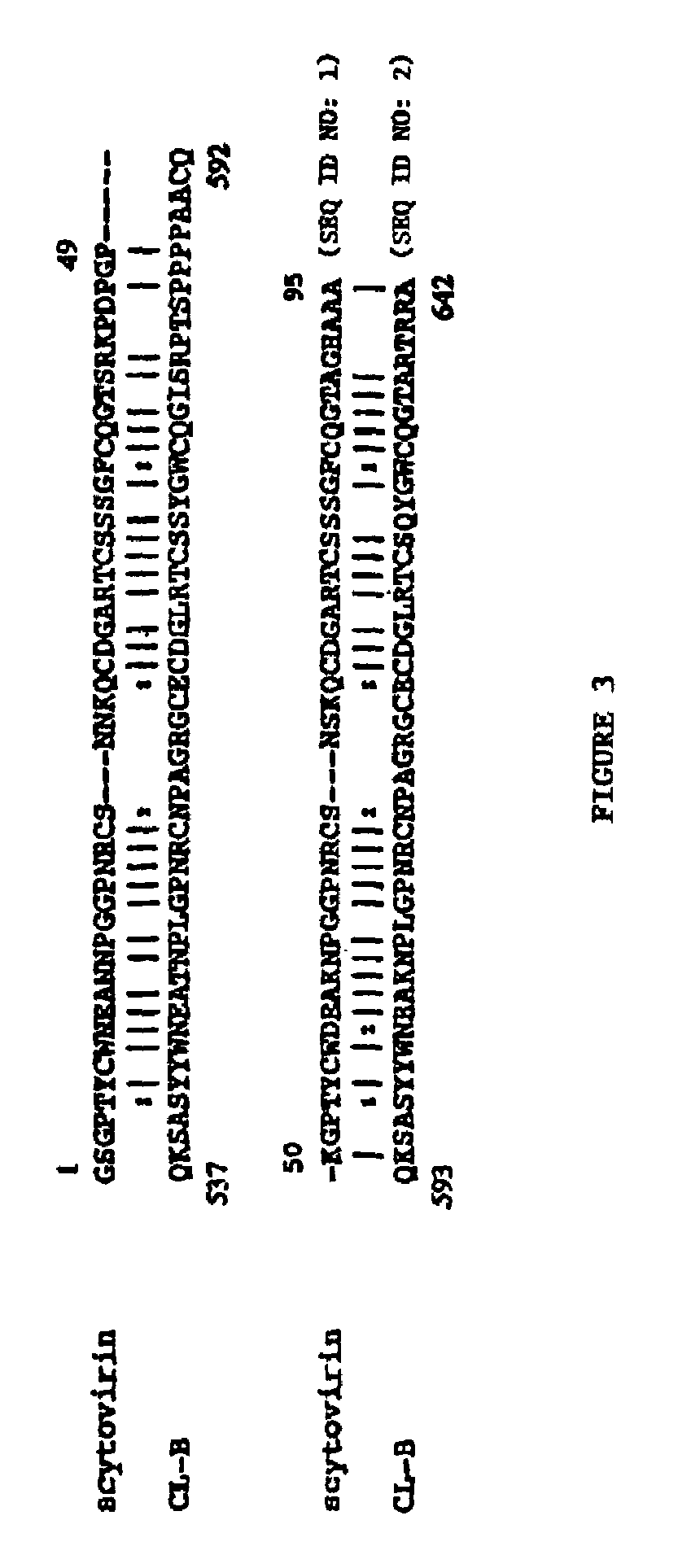Scytovirins and related conjugates, fusion proteins, nucleic acids, vectors, host cells, compositions, antibodies and methods of using scytovirins
a technology of scytovirins and conjugates, applied in the field of antiviral scytovirins, fusion proteins and conjugates, can solve the problems of insufficient therapeutic indices, inability to effectively prevent or treat most viral pathogens, and surprisingly little progress,
- Summary
- Abstract
- Description
- Claims
- Application Information
AI Technical Summary
Benefits of technology
Problems solved by technology
Method used
Image
Examples
example 1
[0156]This example shows details of anti-HIV bioassay-guided isolation, purification and sequence elucidation of scytovirin from aqueous extracts of the cultured cyanobacterium Scytonema varium.
[0157]Experimental details pertinent to Example 1 as well as the subsequent Examples are as follows. All solvents were HPLC grade purchased from EM Science (Gibbstown, N.J.). Endoproteinases Arg-C and Glu-C were obtained from Roche Molecular Biochemicals (Indianapolis, Ind.). The monomeric sugars, wheat germ agglutinin, HSA, BSA, aprotinin, bovine IgG, α-acid glycoprotein and Sephadex G-100 were purchased from Sigma Corp. (St. Louis, Mo.). Oligosaccharides were purchased from Glyko, Inc. (Novato, Calif.). The rgp120 (recombinant, glycosylated, HIV-1IIIB gp120), rgp160 (recombinant, HIV-1IIIB gp160), and rgp41 (recombinant, HIV-1HxB2 gp41, ecto domain) were obtained from Advanced Biotechnologies Incorporated (Columbia, Md.). The sCD4, glycosylated and nonglycosylated gp120 (HIV-1SF2 gp120), H...
example 2
[0171]This example describes the production of anti-scytovirin antibodies.
[0172]A New Zealand white rabbit was immunized with 100 μg of scytovirin in Freund's complete adjuvant. Booster injections of 50 μg of scytovirin in Freund's incomplete adjuvant were administered on days 13, 29, 51, 64, 100, and 195. On days 7, 21, 42, 63, 78, and 112, 10 mL of blood were removed from the rabbit. On day 112 the rabbit was sacrificed and bled out. The IgG fraction of the immune sera of the rabbit was isolated by protein-A Sepharose affinity chromatography (Bio-Rad, Hercules, Calif.) according to the manufacturer's instructions. Reactivity of the polyclonal antibodies for scytovirin was demonstrated by ELISA studies with 1:100 to 1:1,000 of the rabbit immunoglobulin fractions.
example 3
[0173]This example illustrates the evaluation of sequence homologies of a scytovirin with known proteins, and demonstrates that scytovirin does not have strong affinity for chitin.
[0174]A search of the BLAST database (Altschul et al., Nucleic Acid Res. 25: 3389-3402 (1997)) for identification of protein sequence homology indicated some apparent homology (55%) to a subsequence within a much larger cloned polypeptide from the multicellular green alga Volvox carteri (Amon et al., The Plant Cell 10: 781-789 (1998)) (FIG. 3). This polypeptide consists of three repeats of a 48-amino acid, chitin-binding domain separated by an extensin-like module from a cysteine protease domain. Of the 658 amino acids in the cloned polypeptide, scytovirin showed homology to the chitin-binding domain, which consists of a common structural motif of 30-43 amino acids with glycines and cysteines at conserved positions. Although a large number of the cysteines are conserved, scytovirin has a different disulfid...
PUM
| Property | Measurement | Unit |
|---|---|---|
| molecular weight | aaaaa | aaaaa |
| Tm | aaaaa | aaaaa |
| Knauer variable wavelength detector | aaaaa | aaaaa |
Abstract
Description
Claims
Application Information
 Login to View More
Login to View More - R&D
- Intellectual Property
- Life Sciences
- Materials
- Tech Scout
- Unparalleled Data Quality
- Higher Quality Content
- 60% Fewer Hallucinations
Browse by: Latest US Patents, China's latest patents, Technical Efficacy Thesaurus, Application Domain, Technology Topic, Popular Technical Reports.
© 2025 PatSnap. All rights reserved.Legal|Privacy policy|Modern Slavery Act Transparency Statement|Sitemap|About US| Contact US: help@patsnap.com



